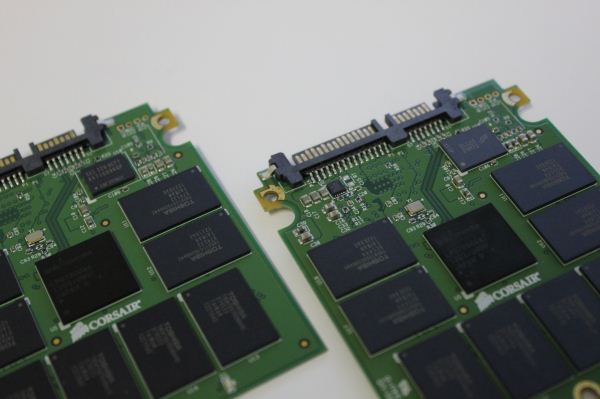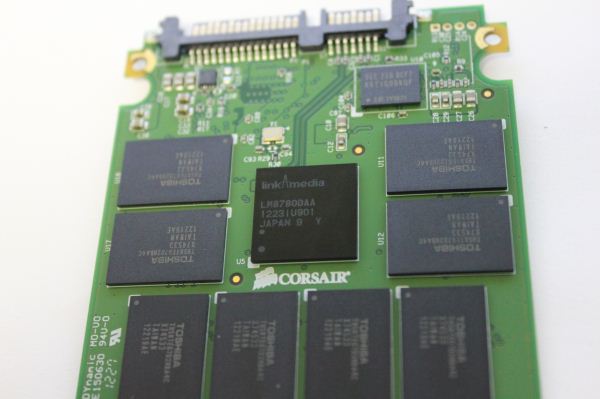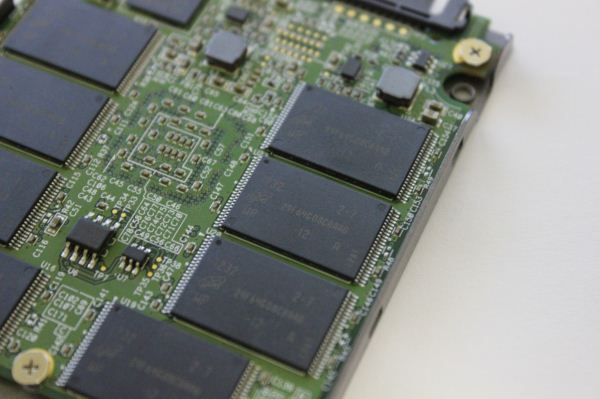Corsair Neutron & Neutron GTX: All Capacities Tested
by Kristian Vättö on December 19, 2012 1:10 PM ESTThe Drives
Corsair surprised us all at Computex this year when they announced their Neutron and Neutron GTX SSDs based on a so-far relatively unknown Link A Media Devices (LAMD) controller. While LAMD was new to the consumer-grade SSD controller market, the company had been making controllers for hard drives and enterprise SSDs for years, so the LM87800 found inside Neutron SSDs wasn't LAMD's first attempt in the storage world. The experience LAMD has gathered in the enterprise world is definitely visible in the LM8700 because even though its LAMD's first consumer-grade controller, it was not dwarfed by SandForce or Marvell.
Overall we were pleasantly surprised with the Neutron when we first reviewed it. There's always room for more competition because not only will it lead to lower prices, it will also provide the market with better products. Lately the consumer SSD market has been flooded with SandForce based SSDs, so it was very refreshing to see something new for a change.
Corsair only sampled the 240GB Neutron and Neutron GTX at the time of the release, which is a common practice among manufacturers. Stock is obviously limited and manufacturers want to get as many units as possible to retailers because ultimately that is what generates them revenue and profit. 240/256GB is usually the sweet-spot in terms of price and performance; smaller capacities perform worse due to less NAND die and higher capacities don't bring any improvements because the bottlenecks are elsewhere (*cough* SATA 6Gbps).
Now, three months later, Corsair finally sent us the rest of the available capacities. Testing different capacities is crucial, especially if the drive has a new controller, because controllers and firmware are designed differently and some design choices result in bigger differences between smaller and larger capacities. For example, the 128GB Vertex 4 is almost as fast as its 256GB and 512GB siblings, whereas the difference between 120GB and 240GB Vertex 3 ranges from negligible to as much as 50-75% (e.g. in write-heavy scenarios). Here's the quick rundown of the various drives.
| Neutron | Neutron GTX | ||||
| Capacity | 120GB | 240GB | 120GB | 240GB | 480GB |
| Raw NAND Capacity | 128GiB | 256GiB | 128GiB | 256GiB | 512GiB |
| NAND | Micron 25nm synchronous MLC | Toshiba 24nm Toggle-Mode 2.0 NAND | |||
| Cache | 128MB | 128MB | 128MB | 128MB | 256MB |
| Sequential Read | 555MB/s | 555MB/s | 555MB/s | 555MB/s | 555MB/s |
| Sequential Write | 211MB/s | 370MB/s | 330MB/s | 511MB/s | 511MB/s |
| 4KB Random Read | 50K IOPS | 85K IOPS | 80K IOPS | 85K IOPS | 90K IOPS |
| 4KB Random Write | 86K IOPS | 87K IOPS | 90K IOPS | 90K IOPS | 85K IOPS |
| Warranty | 5 years | ||||
Toshiba's Toggle-Mode NAND is quite a bit faster than Micron's synchronous ONFi NAND as you can see in the table above. The 120GB Neutron is substantially slower than the 120GB Neutron GTX and there is also a noticeable difference at the capacity of 240GB. Corsair isn't offering a 480GB Neutron so if you're looking for a drive bigger than 240GB, you'll have to pay the premium for the Neutron GTX. Quite a few manufacturers, such as Intel and Plextor, have similar product schemes where only the high-end model offers the highest capacities (Intel SSD 330 tops out at 240GB and Plextor M5S at 256GB).
| Comparison of NAND Interfaces | ||||||
| ONFi | Toggle-Mode | |||||
| Manufacturers | IMFT (Intel, Micron, Spectec), Hynix | Toshiba/SanDisk, Samsung | ||||
| Version | 1.0 | 2.0 | 2.x | 3.0 | 1.0 | 2.0 |
| Max Bandwidth | 50MB/s | 133MB/s | 200MB/s | 400MB/s | 166MB/s | 400MB/s |
The Toggle-Mode interface can currently provide up to twice the bandwidth of ONFi. The interface alone isn't the reason for the difference in performance; Toshiba's NAND is also considerably faster when it comes to program times based on the data I've seen, which would explain why only write speeds are slower on the Neutron.
| Price Comparison (12/18/2012) | |||||
| 120/128GB | 240/256GB | 480/512GB | |||
| Corsair Neutron GTX | $130 | $225 | $455 | ||
| Corsair Neutron | $120 | $190 | N/A | ||
| Corsair Force GS | N/A | $200 | $410 | ||
| Corsair Force GT | $130 | $220 | $440 | ||
| Plextor M5 Pro | $125 | $200 | $460 | ||
| Plextor M5S | $105 | $200 | N/A | ||
| Crucial m4 | $110 | $190 | $383 | ||
| Intel SSD 520 | $129 | $220 | $445 | ||
| Intel SSD 330 | $113 | $179 | N/A | ||
| Samsung SSD 840 Pro | $139 | $260 | $577 | ||
| Samsung SSD 840 | $100 | $169 | $315 | ||
| OCZ Vector | $150 | $270 | $555 | ||
| OCZ Vertex 4 | $108 | $210 | $458 | ||
Neither the Neutron or the Neutron GTX is the cheapest SSD available, but the pricing is still fair. Compared to the OCZ Vector or Samsung SSD 840 Pro, the Neutron GTX is actually quite a bit cheaper, although performance is at a different level as well. As always, prices fluctuate a lot so it's hard to draw any conclusions based on one day's pricing—it can be totally different in less than a week.
In fact, just to show you how prices fluctuate, here's the same table as above, only with prices from just over two weeks ago; I've italicized and bolded the differences, which you can see is about 80% of the SSDs we've listed. Sure, it's the Christmas season and so we're more prone than ever to price fluctuations, but in particular some of the newer drives (like the Samsung 840 500GB) as well as some of the older outgoing models (e.g. OCZ Vertex 4 and Intel 520) have seen some pretty heft price cuts. Be sure to shop around!
| Price Comparison (12/1/2012) | |||||
| 120/128GB | 240/256GB | 480/512GB | |||
| Corsair Neutron GTX | $140 | $230 | $470 | ||
| Corsair Neutron | $120 | $205 | N/A | ||
| Corsair Force GS | N/A | $220 | $450 | ||
| Corsair Force GT | $130 | $220 | $440 | ||
| Plextor M5 Pro | $130 | $250 | $460 | ||
| Plextor M5S | $110 | $200 | N/A | ||
| Crucial m4 | $110 | $200 | $385 | ||
| Intel SSD 520 | $130 | $250 | $490 | ||
| Intel SSD 330 | $115 | $200 | N/A | ||
| Samsung SSD 840 Pro | $194 | $270 | $600 | ||
| Samsung SSD 840 | $105 | $179 | $392 | ||
| OCZ Vector | $160 | $290 | $570 | ||
| OCZ Vertex 4 | $140 | $236 | $475 | ||
Inside the Drives
| NAND Type | NAND Configuration | NAND Part Number | |
| Neutron | |||
| 120GB | Micron 25nm synchronous MLC | 16x 8GiB packages | 29F64G08CBAAB |
| 240GB | 16x 2x8GiB packages | 29F128G08CFAAB | |
| Neutron GTX | |||
| 120GB | Toshiba 24nm Toggle-Mode MLC | 8x 2x8GiB packages | TH58TEG7D2HBA4C |
| 240GB | 8x 4x8GiB packages | TH58TEG8D2HBA4C | |
| 480GB | 8x 8x8GiB packages | TH58TEG9D2HBA4C |
Neutron GTX 120GB and 480GB
In general, the only difference between the various capacities is the amount of cache and NAND per die. The 480GB model is the only one with 256MB (two 128MB chips) of cache; other models have 128MB. Both DRAM caches are DDR2-800 like in the 240GB Neutron GTX, but Corsair has opted for Micron's DRAM in the 480GB model whereas the 120GB and 240GB models use DRAM from Samsung.
LM87800—The heart of Corsair's Neutron series
Micron's ONFI NAND in 120GB Neutron
Test System
| CPU |
Intel Core i5-2500K running at 3.3GHz (Turbo and EIST enabled) |
| Motherboard |
AsRock Z68 Pro3 |
| Chipset |
Intel Z68 |
| Chipset Drivers |
Intel 9.1.1.1015 + Intel RST 10.2 |
| Memory | G.Skill RipjawsX DDR3-1600 2 x 4GB (9-9-9-24) |
| Video Card |
XFX AMD Radeon HD 6850 XXX (800MHz core clock; 4.2GHz GDDR5 effective) |
| Video Drivers | AMD Catalyst 10.1 |
| Desktop Resolution | 1920 x 1080 |
| OS | Windows 7 x64 |













44 Comments
View All Comments
infoilrator - Thursday, December 20, 2012 - link
Better in what way?Perceived, benchmark, or price?
Raid0 with another Kingston might be the most cost effective.
The SAMSUNG 840 certainly offers a lot for the price
celestialgrave - Thursday, December 20, 2012 - link
Guess I'll be sticking with my Agility 3 a while longer in the laptop, until someone releases a more frugal powered ssd with good performance.lmcd - Monday, December 24, 2012 - link
... Samsung 840 sips. Doesn't Sandforce take a lot of power?lmcd - Monday, December 24, 2012 - link
Whoops, nvmwell, OCZ 4 series does better than 3 series, either way. And Samsung's results may be faked, as per Oxford Guy's comments.
pattycake0147 - Thursday, December 20, 2012 - link
Why did you choose different scales on the graphs for the final set of consistency graphs? Some top at 50,000 iops and others top at 40,000 iops this makes looking at comparisons more difficult. Even the same drive (840 Pro) has a different scale for the standard and 25% OP graphs.Kristian Vättö - Friday, December 21, 2012 - link
I was aware of this. At first 40K IOPS was enough but when we started including 25% OP tests, many SSDs managed over 40K IOPS so it was obvious that the scale had to be extended. I'll try to make all graphs 50K IOPS for the next review - Anand has done most of the tests so I couldn't create new graphs for this one.Oxford Guy - Friday, December 21, 2012 - link
Anandtech should expose Samsung's lies, regarding the load power usage of their SSDs.It certainly does not here:
"the 840 Pro boasts incredibly low power consumption both at idle and under load"
Perhaps, but the actual usage is much higher than Samsung's packaging claim.
http://www.anandtech.com/show/6328/samsung-ssd-840...
Or here:
"Until we get lower capacity drives it's impossible to tell how much the power consumption story will change."
How convenient it was for Samsung to only provide a 512 GB unit.
http://www.anandtech.com/show/4863/the-samsung-ssd...
Let's see what Samsung claims with their "full specs" page:
http://www.samsung.com/us/computer/memory-storage/...
.13W — miraculous!
And, let's see what Samsung provided Newegg for its 512 GB drive, eh?
Power consumption idle: .008W
Power consumption load: .13W
http://www.newegg.com/Product/Product.aspx?Item=N8...
People have routinely cited Samsung's "efficient" design, citing these false numbers, in comparisons with other drives. This has to stop. Anandtech, you have a responsibility to report on this, not cover for them.
Let's see what the 840 512's "full specs" are, eh?
http://www.samsung.com/us/computer/memory-storage/...
Well, Samsung certainly learned their lesson thanks to Anandtech. They've raised the power consumption to .15W!
Oxford Guy - Friday, December 21, 2012 - link
Oh, and let's take a look at the numbers Samsung provided Newegg for the 512 GB 840, shall we?power consumption idle: 0.054W
power consumption load: 0.069W
Oxford Guy - Friday, December 21, 2012 - link
OCZ has felt heat from Anandtech over its sleazy practice of changing the NAND of its drives from 32-bit to 64-bit without changing the specs on the packaging.Why not Samsung? The 830 has the highest power consumption in this latest roundup, and yet did Anandtech compare the claimed .13W power usage to the actual power usage?
"Until we get lower capacity drives it's impossible to tell how much the power consumption story will change."
How about "This 512 GB drive uses vastly more power than Samsung claims it does. We are going to find out just how much the lower-capacity drives use and write a story about these serious discrepancies."?
That would have been more appropriate.
derGhostrider - Saturday, December 22, 2012 - link
What is your problem "Oxford Guy"?Almost noone cares about power consumption of 1W or 3W or 0.15W for a SSD, except when you try to build an ultra durable ultra-book or tablet PC.
But even then you have to consider that the Samsung 840 pro has the lowest "disk busy time" of all SSDs tested so far.
So it uses more power during its active time but it shortens this time to a minimum.
Take a calculator! It won't be that bad compared to others that use less power but twice as long.
And, if you really care about this little secondary detail that much: Take another SSD that offers the lowest overall power consumption. It won't be that fast but it will satisfy your needs.
Your postings look like a senseless try of bashing the best SSD on the (consumer) market for an almost unimportant little detail. And: You seem to know about it. So make your decision based on your knowledge but don't tripple post just to arouse the image of an issue that might be important.